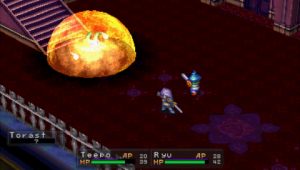Today’s post was originally going to be about an annoyance I’ve found with WildStar advice, but I haven’t finished doing the required math for it yet, so I’ll pick a different topic rather than trying to talk math and being wrong.
A little over a week ago, it was suggested that the Breath Of Fire series might align with my interests. I picked up Breath of Fire 4 on PSN, and played through the intro, but it was recommended I play 3 first. (Breath of Fire is a little bit like Final Fantasy in that the games aren’t direct sequels, but they do share more than most numeric Final Fantasy entries.) The problem is, Breath of Fire 3 isn’t on PSN, and the PSP version was never released in this country. Despite that, it was fairly cheap, so now I’m the proud owner of a PSP copy of Breath of Fire 3. I immediately ripped it and stuck it on my PSP Go.

Starting Breath of Fire 3 is certainly interesting, I won’t spoil it for people who haven’t played it, but it’s not your usual “first battle against nonthreatening enemies with your main character” that so many JRPGs use. Soon after that, you do pick up as the main character (default name: Ryu) and things are a bit more standard. I just started playing recently, and I like the way the party is shaping up. In addition to doing decent damage with a sword, Ryu also has healing and protective spells. Teepo has a very similar stat spread, but instead picks up offensive spells. Sometimes party member Rei is both faster and stronger than the other two due to his natural stats and his higher starting level, but he leaves the party on occasion during the start of the game. I suspect the other two will have caught up by the time I get him back.

The actual systems are somewhat interesting. It’s fairly basic stuff, with each combatant acting in battle according to their speed. Characters who are fast enough (mostly this means Rei) can actually get an extra turn in an “EX round”, taking two actions for the enemies’ one. An interesting thing is that in addition to abilities learned naturally, you can use the “examine” command in combat to attempt to watch enemies and learn their skills. At this point I’ve managed to pick up a fire attack from a slime-like enemy (Does every game have these?), a bite attack from a guard dog, and a jump attack from a giant chicken. These skills can be transferred between party members with the use of an item. I like that the actual battles are fought in the normal areas, without transitioning to a separate battle screen (although characters do reposition as enemies spawn in).

Overall, this game reminds my why I liked the PS-era JRPGs. It’s fairly simple, looks good, and is fun to play. It might get overly bogged down in plot and lose me later, but I’m enjoying it so far.
